PROJ6011 Integrated Infrastructure Project Management Case Study NRAH
VerifiedAdded on 2023/06/03
|7
|1556
|279
Case Study
AI Summary
This case study examines the New Royal Adelaide Hospital (NRAH) project as an example of integrated infrastructure project management, focusing on its public-private partnership structure and its impact. The project aimed to replace the old hospital with a modern healthcare facility, but faced challenges related to funding, stakeholder management, and project execution. While initially promising job creation and government benefits, the project's failure to meet deadlines negatively impacted society. The triple bottom line (economic, social, and environmental) was considered, but economic factors suffered due to cost overruns. The study identifies improvements in project execution, such as critical path analysis and high-performance teams, and highlights leadership lessons, emphasizing better relationships between government and private organizations, effective communication, and project visualization. Desklib provides access to similar solved assignments and past papers for students.

Running head: INTEGRATED INFRASTRUCTURE PROJECT MANAGEMENT
Integrated Infrastructure Project Management
Name of the Student
Name of the University
Author Note
Integrated Infrastructure Project Management
Name of the Student
Name of the University
Author Note
Paraphrase This Document
Need a fresh take? Get an instant paraphrase of this document with our AI Paraphraser
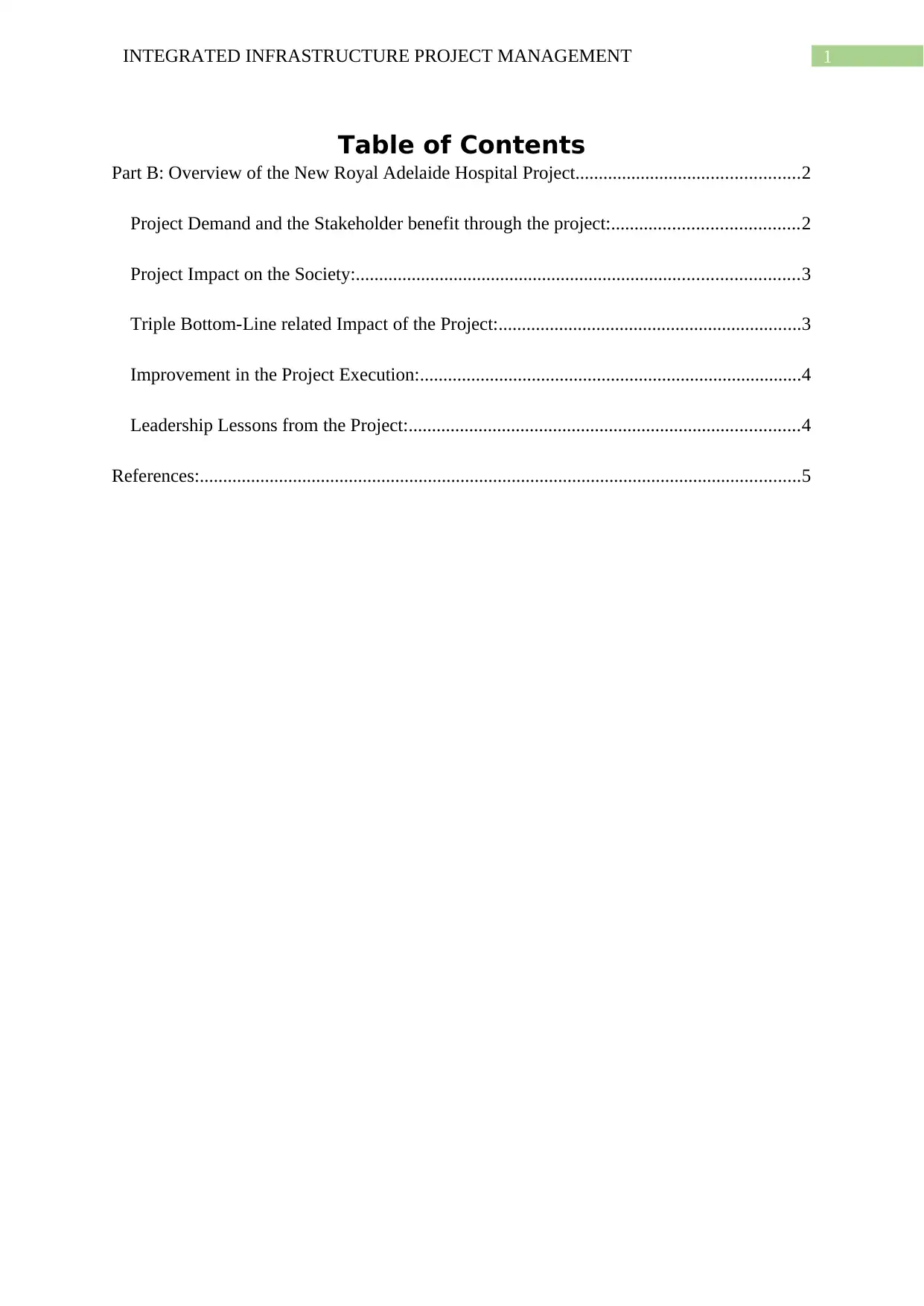
1INTEGRATED INFRASTRUCTURE PROJECT MANAGEMENT
Table of Contents
Part B: Overview of the New Royal Adelaide Hospital Project................................................2
Project Demand and the Stakeholder benefit through the project:........................................2
Project Impact on the Society:...............................................................................................3
Triple Bottom-Line related Impact of the Project:.................................................................3
Improvement in the Project Execution:..................................................................................4
Leadership Lessons from the Project:....................................................................................4
References:.................................................................................................................................5
Table of Contents
Part B: Overview of the New Royal Adelaide Hospital Project................................................2
Project Demand and the Stakeholder benefit through the project:........................................2
Project Impact on the Society:...............................................................................................3
Triple Bottom-Line related Impact of the Project:.................................................................3
Improvement in the Project Execution:..................................................................................4
Leadership Lessons from the Project:....................................................................................4
References:.................................................................................................................................5
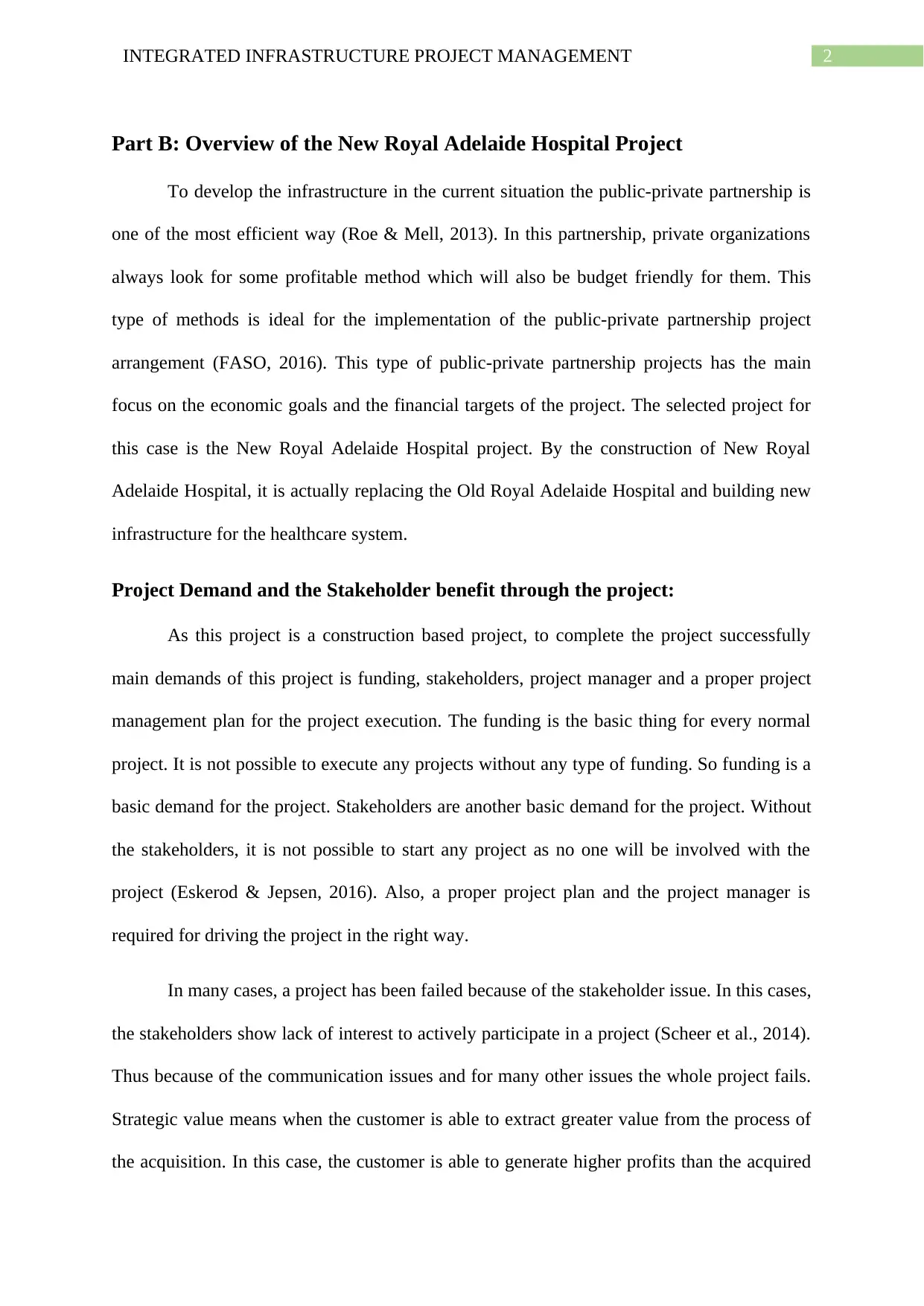
2INTEGRATED INFRASTRUCTURE PROJECT MANAGEMENT
Part B: Overview of the New Royal Adelaide Hospital Project
To develop the infrastructure in the current situation the public-private partnership is
one of the most efficient way (Roe & Mell, 2013). In this partnership, private organizations
always look for some profitable method which will also be budget friendly for them. This
type of methods is ideal for the implementation of the public-private partnership project
arrangement (FASO, 2016). This type of public-private partnership projects has the main
focus on the economic goals and the financial targets of the project. The selected project for
this case is the New Royal Adelaide Hospital project. By the construction of New Royal
Adelaide Hospital, it is actually replacing the Old Royal Adelaide Hospital and building new
infrastructure for the healthcare system.
Project Demand and the Stakeholder benefit through the project:
As this project is a construction based project, to complete the project successfully
main demands of this project is funding, stakeholders, project manager and a proper project
management plan for the project execution. The funding is the basic thing for every normal
project. It is not possible to execute any projects without any type of funding. So funding is a
basic demand for the project. Stakeholders are another basic demand for the project. Without
the stakeholders, it is not possible to start any project as no one will be involved with the
project (Eskerod & Jepsen, 2016). Also, a proper project plan and the project manager is
required for driving the project in the right way.
In many cases, a project has been failed because of the stakeholder issue. In this cases,
the stakeholders show lack of interest to actively participate in a project (Scheer et al., 2014).
Thus because of the communication issues and for many other issues the whole project fails.
Strategic value means when the customer is able to extract greater value from the process of
the acquisition. In this case, the customer is able to generate higher profits than the acquired
Part B: Overview of the New Royal Adelaide Hospital Project
To develop the infrastructure in the current situation the public-private partnership is
one of the most efficient way (Roe & Mell, 2013). In this partnership, private organizations
always look for some profitable method which will also be budget friendly for them. This
type of methods is ideal for the implementation of the public-private partnership project
arrangement (FASO, 2016). This type of public-private partnership projects has the main
focus on the economic goals and the financial targets of the project. The selected project for
this case is the New Royal Adelaide Hospital project. By the construction of New Royal
Adelaide Hospital, it is actually replacing the Old Royal Adelaide Hospital and building new
infrastructure for the healthcare system.
Project Demand and the Stakeholder benefit through the project:
As this project is a construction based project, to complete the project successfully
main demands of this project is funding, stakeholders, project manager and a proper project
management plan for the project execution. The funding is the basic thing for every normal
project. It is not possible to execute any projects without any type of funding. So funding is a
basic demand for the project. Stakeholders are another basic demand for the project. Without
the stakeholders, it is not possible to start any project as no one will be involved with the
project (Eskerod & Jepsen, 2016). Also, a proper project plan and the project manager is
required for driving the project in the right way.
In many cases, a project has been failed because of the stakeholder issue. In this cases,
the stakeholders show lack of interest to actively participate in a project (Scheer et al., 2014).
Thus because of the communication issues and for many other issues the whole project fails.
Strategic value means when the customer is able to extract greater value from the process of
the acquisition. In this case, the customer is able to generate higher profits than the acquired
⊘ This is a preview!⊘
Do you want full access?
Subscribe today to unlock all pages.

Trusted by 1+ million students worldwide
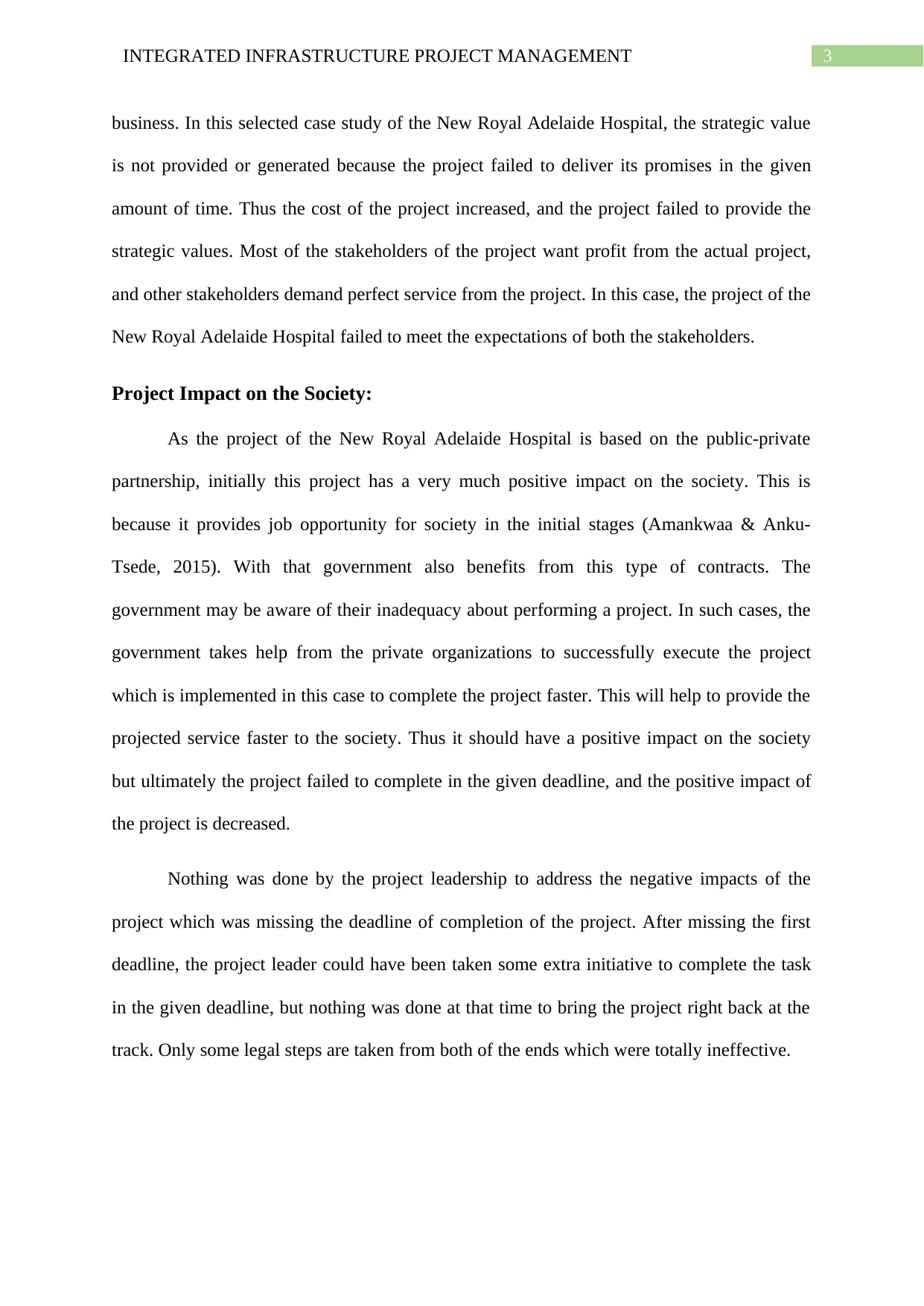
3INTEGRATED INFRASTRUCTURE PROJECT MANAGEMENT
business. In this selected case study of the New Royal Adelaide Hospital, the strategic value
is not provided or generated because the project failed to deliver its promises in the given
amount of time. Thus the cost of the project increased, and the project failed to provide the
strategic values. Most of the stakeholders of the project want profit from the actual project,
and other stakeholders demand perfect service from the project. In this case, the project of the
New Royal Adelaide Hospital failed to meet the expectations of both the stakeholders.
Project Impact on the Society:
As the project of the New Royal Adelaide Hospital is based on the public-private
partnership, initially this project has a very much positive impact on the society. This is
because it provides job opportunity for society in the initial stages (Amankwaa & Anku-
Tsede, 2015). With that government also benefits from this type of contracts. The
government may be aware of their inadequacy about performing a project. In such cases, the
government takes help from the private organizations to successfully execute the project
which is implemented in this case to complete the project faster. This will help to provide the
projected service faster to the society. Thus it should have a positive impact on the society
but ultimately the project failed to complete in the given deadline, and the positive impact of
the project is decreased.
Nothing was done by the project leadership to address the negative impacts of the
project which was missing the deadline of completion of the project. After missing the first
deadline, the project leader could have been taken some extra initiative to complete the task
in the given deadline, but nothing was done at that time to bring the project right back at the
track. Only some legal steps are taken from both of the ends which were totally ineffective.
business. In this selected case study of the New Royal Adelaide Hospital, the strategic value
is not provided or generated because the project failed to deliver its promises in the given
amount of time. Thus the cost of the project increased, and the project failed to provide the
strategic values. Most of the stakeholders of the project want profit from the actual project,
and other stakeholders demand perfect service from the project. In this case, the project of the
New Royal Adelaide Hospital failed to meet the expectations of both the stakeholders.
Project Impact on the Society:
As the project of the New Royal Adelaide Hospital is based on the public-private
partnership, initially this project has a very much positive impact on the society. This is
because it provides job opportunity for society in the initial stages (Amankwaa & Anku-
Tsede, 2015). With that government also benefits from this type of contracts. The
government may be aware of their inadequacy about performing a project. In such cases, the
government takes help from the private organizations to successfully execute the project
which is implemented in this case to complete the project faster. This will help to provide the
projected service faster to the society. Thus it should have a positive impact on the society
but ultimately the project failed to complete in the given deadline, and the positive impact of
the project is decreased.
Nothing was done by the project leadership to address the negative impacts of the
project which was missing the deadline of completion of the project. After missing the first
deadline, the project leader could have been taken some extra initiative to complete the task
in the given deadline, but nothing was done at that time to bring the project right back at the
track. Only some legal steps are taken from both of the ends which were totally ineffective.
Paraphrase This Document
Need a fresh take? Get an instant paraphrase of this document with our AI Paraphraser
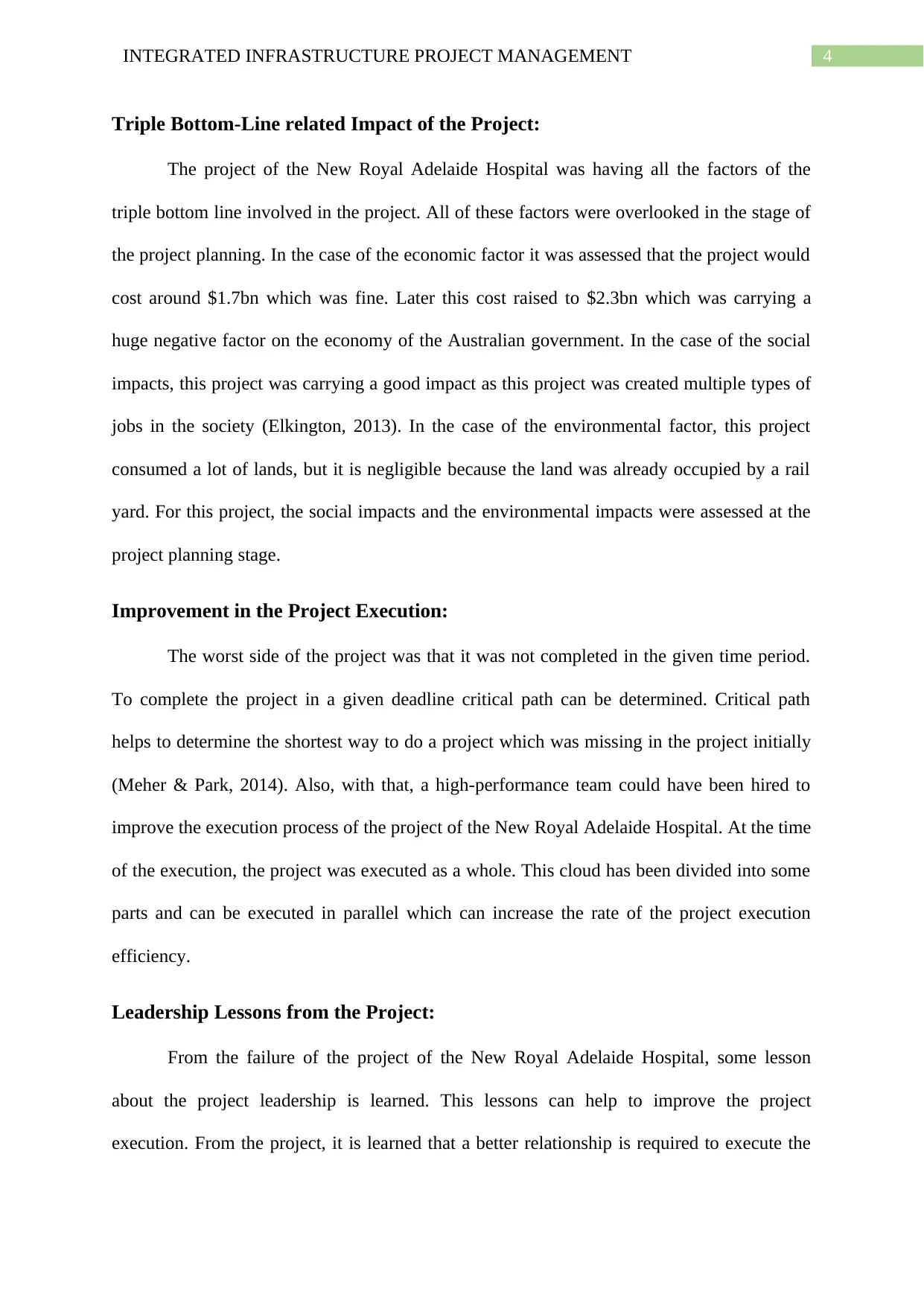
4INTEGRATED INFRASTRUCTURE PROJECT MANAGEMENT
Triple Bottom-Line related Impact of the Project:
The project of the New Royal Adelaide Hospital was having all the factors of the
triple bottom line involved in the project. All of these factors were overlooked in the stage of
the project planning. In the case of the economic factor it was assessed that the project would
cost around $1.7bn which was fine. Later this cost raised to $2.3bn which was carrying a
huge negative factor on the economy of the Australian government. In the case of the social
impacts, this project was carrying a good impact as this project was created multiple types of
jobs in the society (Elkington, 2013). In the case of the environmental factor, this project
consumed a lot of lands, but it is negligible because the land was already occupied by a rail
yard. For this project, the social impacts and the environmental impacts were assessed at the
project planning stage.
Improvement in the Project Execution:
The worst side of the project was that it was not completed in the given time period.
To complete the project in a given deadline critical path can be determined. Critical path
helps to determine the shortest way to do a project which was missing in the project initially
(Meher & Park, 2014). Also, with that, a high-performance team could have been hired to
improve the execution process of the project of the New Royal Adelaide Hospital. At the time
of the execution, the project was executed as a whole. This cloud has been divided into some
parts and can be executed in parallel which can increase the rate of the project execution
efficiency.
Leadership Lessons from the Project:
From the failure of the project of the New Royal Adelaide Hospital, some lesson
about the project leadership is learned. This lessons can help to improve the project
execution. From the project, it is learned that a better relationship is required to execute the
Triple Bottom-Line related Impact of the Project:
The project of the New Royal Adelaide Hospital was having all the factors of the
triple bottom line involved in the project. All of these factors were overlooked in the stage of
the project planning. In the case of the economic factor it was assessed that the project would
cost around $1.7bn which was fine. Later this cost raised to $2.3bn which was carrying a
huge negative factor on the economy of the Australian government. In the case of the social
impacts, this project was carrying a good impact as this project was created multiple types of
jobs in the society (Elkington, 2013). In the case of the environmental factor, this project
consumed a lot of lands, but it is negligible because the land was already occupied by a rail
yard. For this project, the social impacts and the environmental impacts were assessed at the
project planning stage.
Improvement in the Project Execution:
The worst side of the project was that it was not completed in the given time period.
To complete the project in a given deadline critical path can be determined. Critical path
helps to determine the shortest way to do a project which was missing in the project initially
(Meher & Park, 2014). Also, with that, a high-performance team could have been hired to
improve the execution process of the project of the New Royal Adelaide Hospital. At the time
of the execution, the project was executed as a whole. This cloud has been divided into some
parts and can be executed in parallel which can increase the rate of the project execution
efficiency.
Leadership Lessons from the Project:
From the failure of the project of the New Royal Adelaide Hospital, some lesson
about the project leadership is learned. This lessons can help to improve the project
execution. From the project, it is learned that a better relationship is required to execute the
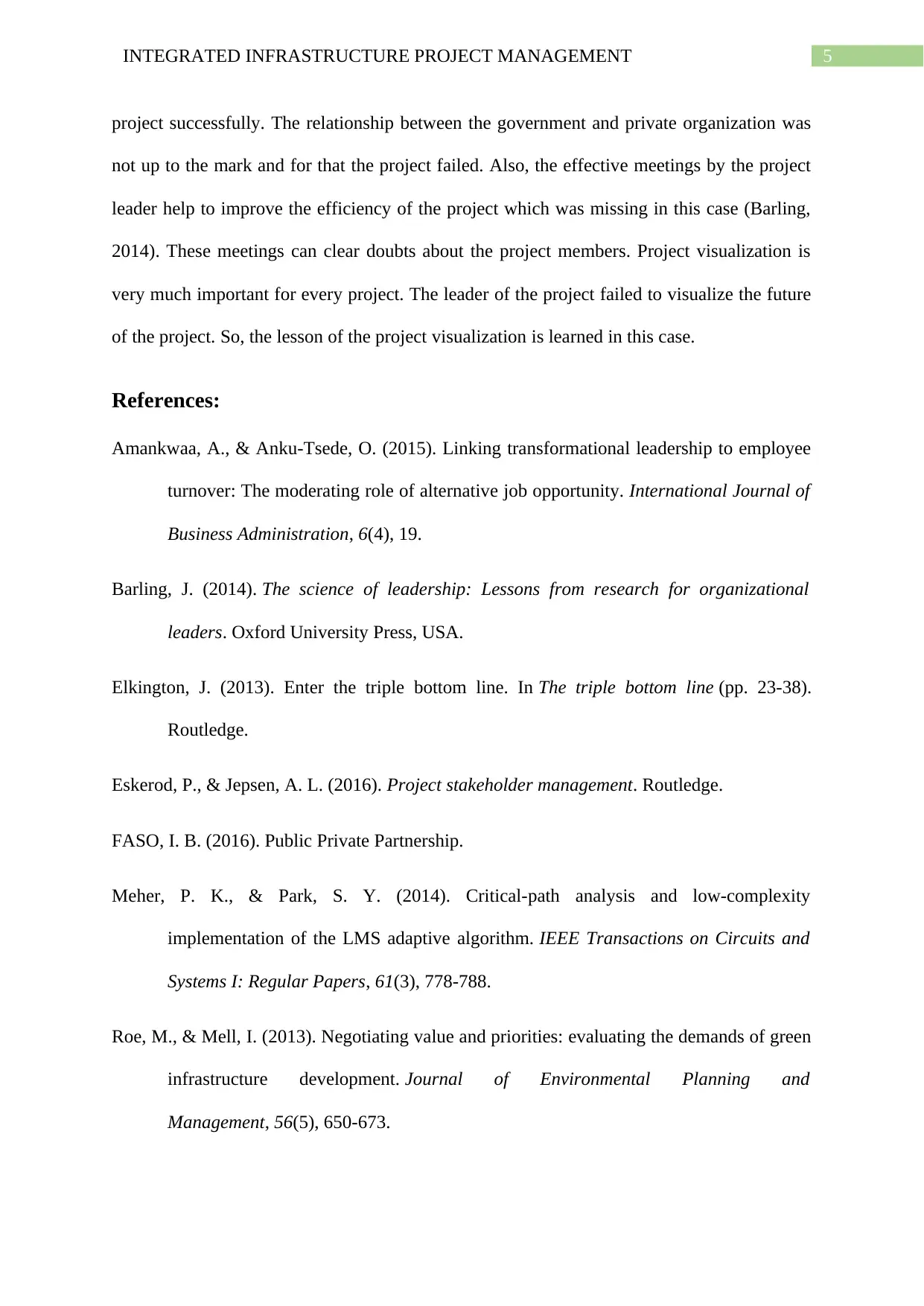
5INTEGRATED INFRASTRUCTURE PROJECT MANAGEMENT
project successfully. The relationship between the government and private organization was
not up to the mark and for that the project failed. Also, the effective meetings by the project
leader help to improve the efficiency of the project which was missing in this case (Barling,
2014). These meetings can clear doubts about the project members. Project visualization is
very much important for every project. The leader of the project failed to visualize the future
of the project. So, the lesson of the project visualization is learned in this case.
References:
Amankwaa, A., & Anku-Tsede, O. (2015). Linking transformational leadership to employee
turnover: The moderating role of alternative job opportunity. International Journal of
Business Administration, 6(4), 19.
Barling, J. (2014). The science of leadership: Lessons from research for organizational
leaders. Oxford University Press, USA.
Elkington, J. (2013). Enter the triple bottom line. In The triple bottom line (pp. 23-38).
Routledge.
Eskerod, P., & Jepsen, A. L. (2016). Project stakeholder management. Routledge.
FASO, I. B. (2016). Public Private Partnership.
Meher, P. K., & Park, S. Y. (2014). Critical-path analysis and low-complexity
implementation of the LMS adaptive algorithm. IEEE Transactions on Circuits and
Systems I: Regular Papers, 61(3), 778-788.
Roe, M., & Mell, I. (2013). Negotiating value and priorities: evaluating the demands of green
infrastructure development. Journal of Environmental Planning and
Management, 56(5), 650-673.
project successfully. The relationship between the government and private organization was
not up to the mark and for that the project failed. Also, the effective meetings by the project
leader help to improve the efficiency of the project which was missing in this case (Barling,
2014). These meetings can clear doubts about the project members. Project visualization is
very much important for every project. The leader of the project failed to visualize the future
of the project. So, the lesson of the project visualization is learned in this case.
References:
Amankwaa, A., & Anku-Tsede, O. (2015). Linking transformational leadership to employee
turnover: The moderating role of alternative job opportunity. International Journal of
Business Administration, 6(4), 19.
Barling, J. (2014). The science of leadership: Lessons from research for organizational
leaders. Oxford University Press, USA.
Elkington, J. (2013). Enter the triple bottom line. In The triple bottom line (pp. 23-38).
Routledge.
Eskerod, P., & Jepsen, A. L. (2016). Project stakeholder management. Routledge.
FASO, I. B. (2016). Public Private Partnership.
Meher, P. K., & Park, S. Y. (2014). Critical-path analysis and low-complexity
implementation of the LMS adaptive algorithm. IEEE Transactions on Circuits and
Systems I: Regular Papers, 61(3), 778-788.
Roe, M., & Mell, I. (2013). Negotiating value and priorities: evaluating the demands of green
infrastructure development. Journal of Environmental Planning and
Management, 56(5), 650-673.
⊘ This is a preview!⊘
Do you want full access?
Subscribe today to unlock all pages.

Trusted by 1+ million students worldwide

6INTEGRATED INFRASTRUCTURE PROJECT MANAGEMENT
Scheer, D., Benighaus, C., Benighaus, L., Renn, O., Gold, S., Röder, B., & Böl, G. F. (2014).
The distinction between risk and hazard: understanding and use in stakeholder
communication. Risk Analysis, 34(7), 1270-1285.
Scheer, D., Benighaus, C., Benighaus, L., Renn, O., Gold, S., Röder, B., & Böl, G. F. (2014).
The distinction between risk and hazard: understanding and use in stakeholder
communication. Risk Analysis, 34(7), 1270-1285.
1 out of 7
Related Documents
Your All-in-One AI-Powered Toolkit for Academic Success.
+13062052269
info@desklib.com
Available 24*7 on WhatsApp / Email
![[object Object]](/_next/static/media/star-bottom.7253800d.svg)
Unlock your academic potential
Copyright © 2020–2025 A2Z Services. All Rights Reserved. Developed and managed by ZUCOL.




